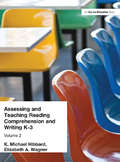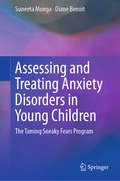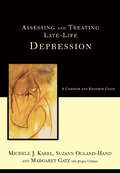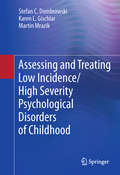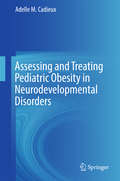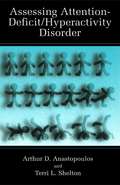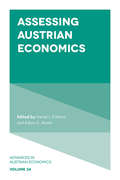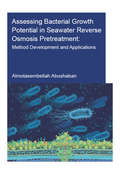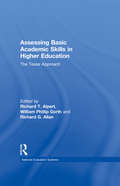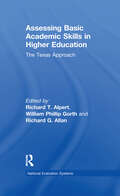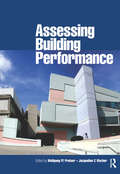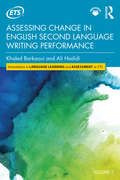- Table View
- List View
Assessing and Teaching Reading Composition and Writing, K-3, Vol. 2
by K. Michael Hibbard Elizabeth WagnerThe performance tasks in this book are linked directly to instructional strategies and include holistic rubrics, analytic rubrics, and assessment lists. They can be photocopied and distributed to your students.
Assessing and Treating Anxiety Disorders in Young Children: The Taming Sneaky Fears Program
by Suneeta Monga Diane BenoitThis book examines assessment and treatment methods for anxiety disorders in four- to- seven-year-olds. It discusses risk and protective factors in the preschool years, comorbidities, and how conditions such as separation anxiety disorder, social anxiety disorder, and selective mutism present in this age group. The book examines limitations of current definitions, assessment methods, and interventions. Chapters offer a theoretical framework from which to understand how traditional cognitive-behavior therapy (CBT) strategies can be used effectively in this age group. It offers a detailed description of the Taming Sneaky Fears program, an innovative, evidence-based group CBT program for four- to seven-year-old anxious children and their parents. It provides step-by-step instructions on how to implement Taming Sneaky Fears. The book concludes by addressing common challenges, influences, and outcomes for four- to seven-year-old anxious children and their families and provides recommendations for reducing the barriers to healthy development. Topics featured in this book include:Screening and assessment tools for young anxious children.Innovative assessment approaches for young anxious children.The use of Bravery Ladders to teach young children to overcome their fears and anxieties.Specific adaptations of the Taming Sneaky Fears program for selective mutism and social anxiety disorder. The pivotal role of parents in the success of the Taming Sneaky Fears program.Assessing and Treating Anxiety Disorders in Young Children is a must-have resource for researchers, clinicians and related professionals, and graduate students in child and school psychology, pediatrics, social work, and psychiatry.
Assessing and Treating Emotionally Inexpressive Men (The Routledge Series on Counseling and Psychotherapy with Boys and Men)
by Ronald F. Levant and Shana PryorWhat if your new client, a man in his early 40s, cannot answer basic questions in your initial assessment interview? You were aware that many men do not like to talk about their feelings, but this client seems kind of frozen. You think he might be alexithymic, but you do not know how to assess for that, or even more importantly, how to treat it. Assessing and Treating Emotionally Inexpressive Men has answers. Chapters explain why some men are emotionally inexpressive because of their childhood socialization, and the book provides both scales for assessing alexithymia in men and treatment manuals for helping these men became more emotionally self-aware in individual and group therapy. The book also offers case studies that explains how to integrate the authors’ approach with any model of psychotherapy. Clinicians will come away from this book with a clear sense for how to treat alexithymia in the early sessions of psychotherapy and thereby improve treatment uptake and outcomes.
Assessing and Treating Emotionally Inexpressive Men (The Routledge Series on Counseling and Psychotherapy with Boys and Men)
What if your new client, a man in his early 40s, cannot answer basic questions in your initial assessment interview? You were aware that many men do not like to talk about their feelings, but this client seems kind of frozen. You think he might be alexithymic, but you do not know how to assess for that, or even more importantly, how to treat it. Assessing and Treating Emotionally Inexpressive Men has answers. Chapters explain why some men are emotionally inexpressive because of their childhood socialization, and the book provides both scales for assessing alexithymia in men and treatment manuals for helping these men became more emotionally self-aware in individual and group therapy. The book also offers case studies that explains how to integrate the authors’ approach with any model of psychotherapy. Clinicians will come away from this book with a clear sense for how to treat alexithymia in the early sessions of psychotherapy and thereby improve treatment uptake and outcomes.
Assessing And Treating Late-life Depression: A Casebook And Resource Guide
by Michele J. Karel Margaret Gatz Suzanne Ogland-handNot only is depression among the elderly treatable but, given its increase in incidence and a rapidly aging population, it is a critical issue for the mental-health and medical communities. The authors review the range of late-life depressive syndromes and the strategies for assessing and treating them, and illustrate the problems and principles with fourteen extended case studies-rare in the geropsychology literature and the core of the book. They also provide a guide to medications, screening tools, innovative models, and supplementary resources, invaluable tools for mental-health professionals and medical practitioners alike.
Assessing and Treating Low Incidence/High Severity Psychological Disorders of Childhood
by Stefan C. Dombrowski Karen L. Gischlar Martin MrazikDuring the past several decades, interest in children’s psychological disorders has grown steadily within the research community, resulting in a burgeoning knowledge base. The majority of the attention and funding, not surprisingly, has focused on the more prevalent and well-known conditions. Although this raises the odds that young people with more well-known disorders such as ADHD, autism, and learning disorders will receive much-needed professional assessment and intervention, children with less frequently encountered disorders may experience a higher risk of misdiagnosis and inappropriate treatment. Useful data has been scattered throughout the literature for severe-but-less-frequent childhood psychological disorders, including: fire setting; gender identity disorder; impulse control disorders (i.e., kleptomania, trichotillomania, intermittent explosive disorder); selective mutism; Munchausen by proxy; childhood schizophrenia; gang involvement; sexual offending; self-injurious behavior; and feral children. This concise volume offers up-to-date information on these conditions, which, though relatively rare, may have profound effect not only on the children themselves but also their families, friends, and the community at large. Coverage of each disorder is presented in an accessible format covering:Overview and history.Description and diagnostic classification, with proposed changes to the DSM-V.Etiology and theory.Assessment tools and interview protocols.Commonly used psychological and pharmacological treatment options.Current research issues and directions for future investigation. Assessing and Treating Low Incidence/High Severity Psychological Disorders of Childhood is a must-have reference for researchers, clinicians, practitioners, and graduate students in clinical child and school psychology, pediatrics, psychiatry, social work, school counseling, education, and public policy.
Assessing and Treating Pediatric Obesity in Neurodevelopmental Disorders
by Adelle M. CadieuxThis book reviews strategies for assessing and treating pediatric obesity in children with neurodevelopmental disorders (ND). It synthesizes empirical findings and clinical strategies to offer the latest knowledge in key areas, including risk factors, physical activity, nutrition, treatment planning, goal-setting, and engagement with patients. A four-stage treatment model presents clinical guidance in triaging treatment and tailoring interventions to children’s changing medical, behavioral, emotional, and cognitive needs. The book complements current pediatric ND literature by presenting clear guidelines for integrating treatment for obesity into existing treatment of these young patients. Topics featured in this book include: The effect of neurodevelopmental disorders on the assessment of obesity in children.The impact of developmental delays on physical activities and health behaviors.Strategies for promoting weight management goals in pediatric ND.Suggestions on how to engage and support families and caregivers.The role of prevention in weight management within pediatric ND. Assessing and Treating Pediatric Obesity in Neurodevelopmental Disorders is a must-have resource for clinicians, scientist-practitioners, and related professionals as well as researchers, professors, and graduate students in clinical child and school psychology, public health, social work, pediatrics, occupational therapy, and nutrition.
Assessing and Treating Suicidal Thinking and Behaviors in Children and Adolescents: A Play Therapy Guide for Mental Health Professionals in Clinical and School-Based Settings
by Leslie W. Baker Mary Ruth CrossAssessing and Treating Suicidal Thinking and Behaviors in Children and Adolescents is a guide to working with children and young people who present with either obvious or hidden suicidal thoughts, preoccupations, or plans.Chapters explore a range of treatment approaches and focus on how to support parents, caregivers, families, and schools. Expressive therapies are highlighted, but the chapters also cover evidence-based models such as cognitive-behavioral therapy (CBT), dialectical behaviour therapy (DBT), and prescriptive play therapy. Expressive therapists, school-based counselors, and other clinicians who work with at-risk children and adolescents from diverse communities and backgrounds will come away from this book with the tools they need to integrate the individual child’s capabilities, sources of distress, and internal and external resources in order to build a developmentally sensitive treatment plan.
Assessing and Treating Suicidal Thinking and Behaviors in Children and Adolescents: A Play Therapy Guide for Mental Health Professionals in Clinical and School-Based Settings
by Leslie W. Baker Mary Ruth CrossAssessing and Treating Suicidal Thinking and Behaviors in Children and Adolescents is a guide to working with children and young people who present with either obvious or hidden suicidal thoughts, preoccupations, or plans.Chapters explore a range of treatment approaches and focus on how to support parents, caregivers, families, and schools. Expressive therapies are highlighted, but the chapters also cover evidence-based models such as cognitive-behavioral therapy (CBT), dialectical behaviour therapy (DBT), and prescriptive play therapy. Expressive therapists, school-based counselors, and other clinicians who work with at-risk children and adolescents from diverse communities and backgrounds will come away from this book with the tools they need to integrate the individual child’s capabilities, sources of distress, and internal and external resources in order to build a developmentally sensitive treatment plan.
Assessing Attention-Deficit/Hyperactivity Disorder (Topics in Social Psychiatry)
by Arthur D. Anastopoulos Terri L. SheltonOver the past two decades, the assessment of Attention-Deficit/Hyperactivity Disorder (AD/HD) has evolved into a sophisticated balance of science and clinical judgement essential for arriving at reliable and valid diagnostic de- sions. Because of the precarious mix of clinical and empirical skill needed to evaluate children with this disorder, diagnostic practice in this area has been found wanting by many critics. In fact, a 1998 National Institutes of Health consensus panel concluded that “existing diagnostic treatment practices … point to the need for improved awareness by the health service sector conce- ing an appropriate assessment, treatment, and follow-up. A more consistent set of diagnostic procedures and practice guidelines is of utmost importance” (p. 21). Drs. Arthur D. Anastopoulos and Terri L. Shelton have designed a book that addresses this need. A number of themes are highlighted throughout the text. Perhaps the most important is that the assessment guidelines set forth in this book represent a balance between science and practice. The authors account for the realities of clinical practice in an age of managed care while challenging clinicians to heed the lessons of empirical research. Although the use of empirically based asse- ment procedures may at times fly in the face of cost constraints (e. g. , systematic evaluation of medication effects), the authors present a strong argument for them. Further, they call upon their vast clinical experience to provide concrete suggestions for translating research findings into effective evaluations.
Assessing Austrian Economics (Advances in Austrian Economics #24)
by Daniel J. D'Amico Adam G. MartinThe modern school of Austrian economics took shape in the 1970s, and reflects the social science questions of its time. Is it still relevant today, considering that the theories that drive contemporary social science have evolved dramatically over the past few decades? While Austrian concerns such as property rights and imperfect cognition have become more common, other aspects of the Austrian thought are even more idiosyncratic than ever. In the ten chapters included here, leading economists explore whether Austrian economics still has unique insights to offer the world of today. Starting with Peter Boettke’s lead essay, “What is Wrong with Austrian Economics?”, chapters include an array of perspectives responding to this question, ranging from economics, to intellectual history, to political science, and to philosophy. At the end of the volume, Boettke offers a rejoinder, asking, “What is Right About Austrian Economics?” Together, these essays explore the barriers to the spread of Austrian ideas, ask which disciplines might be receptive to them, examine the role of ideology and funding in helping and hindering the school, and consider the advantages and disadvantages of different strategies for expanding engagement with other scholars.
Assessing Austrian Economics (Advances in Austrian Economics #24)
by Daniel J. D’Amico Adam G. MartinThe modern school of Austrian economics took shape in the 1970s, and reflects the social science questions of its time. Is it still relevant today, considering that the theories that drive contemporary social science have evolved dramatically over the past few decades? While Austrian concerns such as property rights and imperfect cognition have become more common, other aspects of the Austrian thought are even more idiosyncratic than ever. In the ten chapters included here, leading economists explore whether Austrian economics still has unique insights to offer the world of today. Starting with Peter Boettke’s lead essay, “What is Wrong with Austrian Economics?”, chapters include an array of perspectives responding to this question, ranging from economics, to intellectual history, to political science, and to philosophy. At the end of the volume, Boettke offers a rejoinder, asking, “What is Right About Austrian Economics?” Together, these essays explore the barriers to the spread of Austrian ideas, ask which disciplines might be receptive to them, examine the role of ideology and funding in helping and hindering the school, and consider the advantages and disadvantages of different strategies for expanding engagement with other scholars.
Assessing Autoethnography: Notes on Analysis, Evaluation, and Craft
by Tony E. Adams Andrew F. HerrmannAssessing Autoethnography provides readers with multiple ways to analyze autoethnographies and other forms of personal narrative writing. Given the proliferation of such forms across academic contexts, the book offers a guide of what autoethnography is, why it matters, and how to do it.Taking each of the three parts of auto-, ethno-, and -graphy in detail, Herrmann, and Adams, provide criteria and points of discussion to ensure robust assessment of an autoethnographic work as a whole. Every chapter is accompanied with exemplars and considers issues such as ethics, storytelling, and good writing. The book discerns the kinds of personal experiences that often work best for autoethnographic projects and provide ways to evaluate fieldwork, interviews, and representations.Written by two experts in the field, Assessing Autoethnography offers guidance to scholars and dissertation advisors, across diverse disciplines, in producing autoethnographic work and utilizing autoethnographic methods. The book will be of interest to researchers in the fields of Communication Studies, Education, Sociology, Women’s and Gender Studies, Critical Race Studies, Mass Communication, English, and other related disciplines.
Assessing Autoethnography: Notes on Analysis, Evaluation, and Craft
by Tony E. Adams Andrew F. HerrmannAssessing Autoethnography provides readers with multiple ways to analyze autoethnographies and other forms of personal narrative writing. Given the proliferation of such forms across academic contexts, the book offers a guide of what autoethnography is, why it matters, and how to do it.Taking each of the three parts of auto-, ethno-, and -graphy in detail, Herrmann, and Adams, provide criteria and points of discussion to ensure robust assessment of an autoethnographic work as a whole. Every chapter is accompanied with exemplars and considers issues such as ethics, storytelling, and good writing. The book discerns the kinds of personal experiences that often work best for autoethnographic projects and provide ways to evaluate fieldwork, interviews, and representations.Written by two experts in the field, Assessing Autoethnography offers guidance to scholars and dissertation advisors, across diverse disciplines, in producing autoethnographic work and utilizing autoethnographic methods. The book will be of interest to researchers in the fields of Communication Studies, Education, Sociology, Women’s and Gender Studies, Critical Race Studies, Mass Communication, English, and other related disciplines.
Assessing Bacterial Growth Potential in Seawater Reverse Osmosis Pretreatment: Method Development and Applications (IHE Delft PhD Thesis Series)
by Almotasembellah AbushabanSeawater desalination is increasingly being used as a means to augment freshwater supplies in regions with high water stress, and reverse osmosis is increasingly the technology of choice because of the low energy consumption. However, seawater reverse osmosis (SWRO) systems suffer from various types of fouling, which can increase energy consumption and the use of chemicals during SWRO operation. In practice, pre-treatment systems are put in place to reduce the particulate and biological fouling potential of SWRO feed water. However, simple, reliable and accurate methods to assess the extent to which biological fouling potential is reduced during pre-treatment are not available for seawater. This research developed a new method to measure bacterial growth potential (BGP) using the native bacterial consortium in seawater. New reagents to extract and detect ATP in microbial cells were specifically developed for seawater. The new lysis and detection reagents overcame the salt interference in seawater and allow low detection of total ATP, free ATP and microbial ATP in seawater. Incorporating a filtration step further increased the sensitivity of the method six fold, enabling ATP detection of ultra-low levels of microbial ATP in seawater. The newly developed ATP-based BGP method was applied to monitor and assess the pre-treatment of five full-scale seawater desalination plants around the world. A good correlation was observed between BGP measured in SWRO feed water and the pressure drop increase in the SWRO systems, suggesting the applicability of using the ATP-based BGP method as a biofouling indicator in SWRO. Furthermore, a safe level of BGP ( In the future, on-line monitoring of BGP in SWRO feed water may further reduce the consumption of chemicals and energy and improve the overall sustainability of seawater desalination by reverse osmosis.
Assessing Bacterial Growth Potential in Seawater Reverse Osmosis Pretreatment: Method Development and Applications (IHE Delft PhD Thesis Series)
by Almotasembellah AbushabanSeawater desalination is increasingly being used as a means to augment freshwater supplies in regions with high water stress, and reverse osmosis is increasingly the technology of choice because of the low energy consumption. However, seawater reverse osmosis (SWRO) systems suffer from various types of fouling, which can increase energy consumption and the use of chemicals during SWRO operation. In practice, pre-treatment systems are put in place to reduce the particulate and biological fouling potential of SWRO feed water. However, simple, reliable and accurate methods to assess the extent to which biological fouling potential is reduced during pre-treatment are not available for seawater. This research developed a new method to measure bacterial growth potential (BGP) using the native bacterial consortium in seawater. New reagents to extract and detect ATP in microbial cells were specifically developed for seawater. The new lysis and detection reagents overcame the salt interference in seawater and allow low detection of total ATP, free ATP and microbial ATP in seawater. Incorporating a filtration step further increased the sensitivity of the method six fold, enabling ATP detection of ultra-low levels of microbial ATP in seawater. The newly developed ATP-based BGP method was applied to monitor and assess the pre-treatment of five full-scale seawater desalination plants around the world. A good correlation was observed between BGP measured in SWRO feed water and the pressure drop increase in the SWRO systems, suggesting the applicability of using the ATP-based BGP method as a biofouling indicator in SWRO. Furthermore, a safe level of BGP ( In the future, on-line monitoring of BGP in SWRO feed water may further reduce the consumption of chemicals and energy and improve the overall sustainability of seawater desalination by reverse osmosis.
Assessing Basic Academic Skills in Higher Education: The Texas Approach
by Richard T. Alpert William P. Gorth Richard G. AllanAddressing the growing concerns about reading, math, and writing skills of freshman-level students, this volume provides different perspectives and approaches to the assessment of basic academic skills in higher education. The book provides an in-depth investigation into the Texas Academic Skills Program (TASP). More generally, the book provides insights into the construction of testing programs and their evaluations. The development and implementation of testing programs is discussed by outstanding educators involved and will be of great value to program administrators, policymakers, deans and faculty members of colleges, state legislators, and educational professionals working directly with institutions of higher learning.
Assessing Basic Academic Skills in Higher Education: The Texas Approach
by Richard T. Alpert, William Phillip Gorth and Richard G. AllanAddressing the growing concerns about reading, math, and writing skills of freshman-level students, this volume provides different perspectives and approaches to the assessment of basic academic skills in higher education. The book provides an in-depth investigation into the Texas Academic Skills Program (TASP). More generally, the book provides insights into the construction of testing programs and their evaluations. The development and implementation of testing programs is discussed by outstanding educators involved and will be of great value to program administrators, policymakers, deans and faculty members of colleges, state legislators, and educational professionals working directly with institutions of higher learning.
Assessing Behaviors Regarded as Problematic: for People with Developmental Disabilities (PDF)
by John ClementsPeople with developmental disabilities sometimes behave in ways that others, or they themselves, regard as problematic. This original book is about what practitioners can do to make sense of behaviors, in order to support clients more effectively. The author offers practical strategies for gathering and analysing information about behaviors, in partnership with the individual concerned, in order to gain a useful understanding of why a particular behavior occurs. The inclusion of case histories, with corresponding behavior plans, clearly demonstrates the real-life application of assessment methods. With its strong emphasis on the importance of establishing equitable, respectful relationships between professionals and people with learning disabilities, this is a book that professionals involved in the lives of people with developmental disabilities will find invaluable.
Assessing Building Performance
by Wolfgang Preiser Jacqueline VischerThe building performance evaluation (BPE) framework emphasizes an evaluative stance throughout the six phases of the building delivery and life cycle: (1) strategic planning/needs analysis; (2) program review; (3) design review; (4) post-construction evaluation/review; (5) post-occupancy evaluation; and, (6) facilities management review/adaptive reuse.The lessons learned from positive and negative building performance are fed into future building delivery cycles. The case studies illustrate how this basic methodology has been adapted to a range of cultural contexts, and indicates the positive results of building performance assessment in a wide range of situations.
Assessing Building Performance
by Wolfgang F.E. Preiser Jacqueline C. VischerThe building performance evaluation (BPE) framework emphasizes an evaluative stance throughout the six phases of the building delivery and life cycle: (1) strategic planning/needs analysis; (2) program review; (3) design review; (4) post-construction evaluation/review; (5) post-occupancy evaluation; and, (6) facilities management review/adaptive reuse.The lessons learned from positive and negative building performance are fed into future building delivery cycles. The case studies illustrate how this basic methodology has been adapted to a range of cultural contexts, and indicates the positive results of building performance assessment in a wide range of situations.
Assessing Business Excellence: A Guide To Business Excellence And Self-assessment
by L. J. Porter S. J. TannerAssessing Business Excellence presents a strategic framework for business excellence and total quality management and shows how you can be actively involved in continuous improvement by systematically reviewing your business activities and results against holistic business excellence frameworks.For all practitioners who seek to use total quality management to improve their organization's effectiveness, efficiency and responsiveness, this title is the essential route map to business excellence. From two leading expert authors comes a book where the most recognized quality award criteria are used to explore the concepts of business excellence and self-assessment. This book:* Introduces the major business excellence and total quality frameworks including The Malcolm Baldrige National Quality Award and the European Quality Award and ISO9000:2000* Compares the frameworks and identifies their strengths and limitations * Introduces the self-assessment process * Explores the main approaches to self-assessment * Illustrates the practical benefits of self-assessment through case examples
Assessing Business Excellence
by Les Porter Steve TannerAssessing Business Excellence presents a strategic framework for business excellence and total quality management and shows how you can be actively involved in continuous improvement by systematically reviewing your business activities and results against holistic business excellence frameworks.For all practitioners who seek to use total quality management to improve their organization's effectiveness, efficiency and responsiveness, this title is the essential route map to business excellence. From two leading expert authors comes a book where the most recognized quality award criteria are used to explore the concepts of business excellence and self-assessment. This book:* Introduces the major business excellence and total quality frameworks including The Malcolm Baldrige National Quality Award and the European Quality Award and ISO9000:2000* Compares the frameworks and identifies their strengths and limitations * Introduces the self-assessment process * Explores the main approaches to self-assessment * Illustrates the practical benefits of self-assessment through case examples
Assessing Change in English Second Language Writing Performance
by Khaled Barkaoui Ali HadidiThis book introduces a new framework for analyzing second language (L2) learners’ written texts. The authors conducted a major study on changes and differences in English L2 learners’ writing performance to advance understanding of the nature of L2 writing development over time, in relation to L2 instruction and testing, and to offer a model that professionals and researchers can use in their own longitudinal and cross-sectional studies of L2 writing development. Grounded in research, data, theory, and technology, this will be a welcome how-to for language test developers, scholars, and graduate students of (L2) writing and assessment.
Assessing Change in English Second Language Writing Performance
by Khaled Barkaoui Ali HadidiThis book introduces a new framework for analyzing second language (L2) learners’ written texts. The authors conducted a major study on changes and differences in English L2 learners’ writing performance to advance understanding of the nature of L2 writing development over time, in relation to L2 instruction and testing, and to offer a model that professionals and researchers can use in their own longitudinal and cross-sectional studies of L2 writing development. Grounded in research, data, theory, and technology, this will be a welcome how-to for language test developers, scholars, and graduate students of (L2) writing and assessment.
